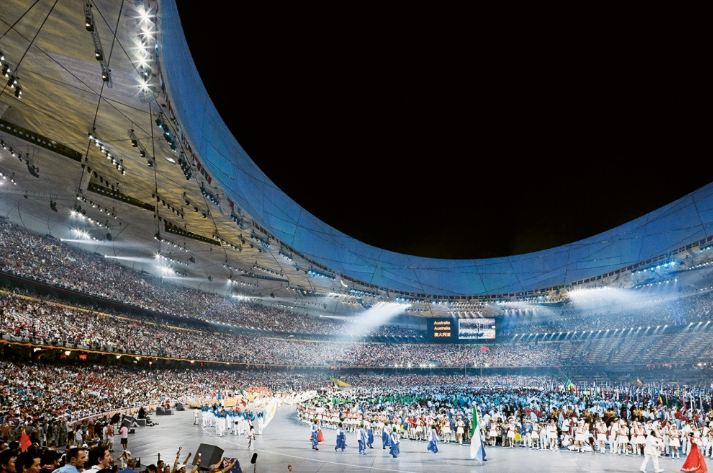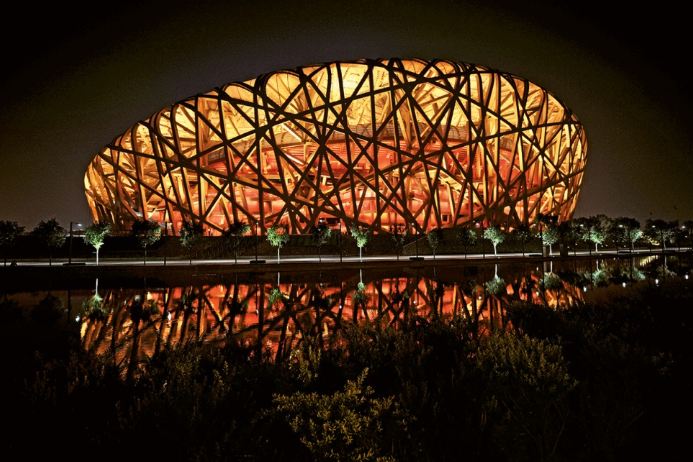The design of the Beijing National Stadium is considered a modern architectural and engineering marvel. It has been designed by Swiss based architects Jacques Herzog and Pierre de Meuron, along with architect Stefan Marbach and China Architecture Design & Research Group led by its chief architect Li Xinggang. The stadium, more popularly known as “Bird’s Nest”, is spread over 254,600 square meters and took around 5 years to build. Created for hosting the 2008 Summer Olympics and Paralympics, it has since become a stunning icon of modern China in a city with a history of over 3,000 years. The construction of the Bird’s Nest, 鸟巢; or Niǎocháo in Chinese, cost a whopping USD 423 million, a small fraction as compared to the USD 40 billion spent for the preparation of the Beijing Olympics event. Today, Bird’s Nest’s technical excellence coupled with its visionary creativity, gels well with the city’s northern urban district, pulsating like a heart for the metropolitan city that is home to almost 22 million residents.

The stadium is an example of the world’s best sports venues in modern times
The design of the Bird’s Nest is inspired in many ways by the Chinese culture. The circular shape of the stadium represents ‘heaven’ and is meant to symbolize the ‘great nature’ on earth, with an overall theme of balance. The steel frame is a reminder of the Chinese-style ‘crazed pottery’. Seemingly random, the pattern abides by complex rules for which advanced geometry was defined. The original concept for the facade came from the idea of a single thread wrapped around in an interlocking shape, much like a nest, thus the more popular name for the stadium.
The brilliance of the latticework is denoted in the multiple pentagrams created by its functional geometry, which are reminiscent of the stars on the Chinese flag. The result of these different design philosophies manifested itself into a bowl-shaped structure with an elliptical crosshatched latticework, depicting the phenomenal artistic maturity that is a hallmark of all Chinses crafts, such as calligraphy, paper cutting, pottery, and even sugar sculpting. According to Herzog & de Meuron “The overall form is developed as an almost round bowl with an ascending and descending rim, which not only embraces the central events in its midst, but also engages with objects from Chinese cultural history.” According to Li Xinggang, “China wanted to have something new for this very important stadium. In an effort to design a stadium that was porous while also being a collective building, a public vessel, the team studied Chinese ceramics. This line of thought brought the team to the nest scheme. In China, a bird’s nest is very expensive, something you only eat on special occasions.”
Today Bird’s Nest is a popular tourist attraction
The enormity of the structure is evident from the fact that it had a total volume of 3 million cubic meters, using 42,000 tons of steel and a total weight of 110,000 tons of structural materials. Just the roof weighs 11,200 tons and was supported by temporary columns, until the stadium was unveiled and the 26 kilometers of unwrapped steel web was in place to hold up the structure. Since this type of steel needed higher welding temperatures, it could only be done in atmospheric temperatures ranging from 15 degrees to 16 degrees Celsius. This meant that the 400 workers had to weld the steel frame only in the evening hours. As one of the larger constructed structures ever built, the stadium is set to live for over 100 years.
Designed to be able to withstand earthquakes of 8.0 magnitude, a mandatory requirement by the Chinese government as China is prone to earthquakes, the roof of the stadium had to be separated from the seating bowl to withstand quakes. Another consideration was the thermal expansion on the steel structure. As the temperature can range from over 30°C in the summer to -20°C in the winter, this was no small consideration. To address all this, the design team worked with Chinese steel producers, Baosteel and Wuhan Iron and Steel in order to develop new customized steel grades that could meet the strength and flexibility standards required for the project
The stadium has a permanent seating capacity for 80,000 spectators
The stadium has an original capacity of 80,000 seats, which was increased to 91,000, for the Olympics. The stadium also has more than 200 accessible seats, which are slightly higher than normal seat height to ensure optimal viewing, in keeping with the user-centric approach. The inside of the stadium features seats colored red on the lower tiers to white on the upper tiers. This gradient provides a feeling of lightness to the otherwise massive structure. The weatherproof roof is composed of a double-layered transparent ETFE (ethylene tetrafluoroethylene) membrane and a translucent PTFE (polytetrafluoroethylene) membrane under it. This helps in filtering light and deflecting sound in a manner that intensifies the impact and incorporation of spotlights into the rim of the roof that creates an ethereal backdrop to the cityscape at night.
The design of the stadium
The stadium, with its seemingly dematerialized leitmotif, garnered attention not only for its bewildering architecture but also for its sustainable design that included the incorporation of natural ventilation, maximized use of daylighting, rainwater harvesting techniques, and solar photovoltaic power generation among others. Beneath the football field, there are 312 Ground Source Heat Pump system wells which can supply heat from the earth to the stadium in winters, and supply cold to the stadium in winters by burying heat exchange tube beneath, which saves much electric power. The rainwater collected by the system of recycling rainwater on the top of the stadium is used to afforest, flush toilets and control fire, saving water resources.
A large team of international and Chinese designers, architects and engineers were involved during the various stages of construction
Today besides the sports events, the structure in a major attraction for any tourist who visits Beijing, drawing 20,000 to 30,000 people a day. The spaces between the interiors and the outside features restaurants, bars, hotels, and retail shops. The structural grid of the stadium provides spaces for walkways, pathways, and recreational spaces like sunken gardens, bamboo groves, mineral hill landscapes, etc. “King of Chinese Pop”, Wang Leehom, held the first solo pop concert at the stadium on 14 April 2012 for a sold-out crowd of 90,000 fans. In 2021, the stadium was used to host “The Great Journey,” an art performance marking the 100th Anniversary of the Chinese Communist Party. In 2022, the opening and closing ceremonies of 2022 Winter Olympics and 2022 Winter Paralympics were held at Bird’s Nest. It is the only stadium to host the opening and closing ceremonies of both the Summer and Winter Olympics and Paralympics . Today Bird’s Nest is a hub of public life that residents of Beijing and tourists cherish equally. Hardeep N from London declared on Tripadvisor.com’s review section about the Bird’s Nest: “….Having seen stadiums from all around the world, including the Nou Camp and the Allianz Arena, and living a stone’s throw away from Wembley Stadium, let me tell you, that none of them come close to how imposing the Birds Nest is.”

















